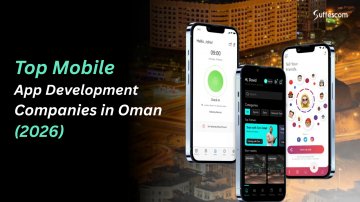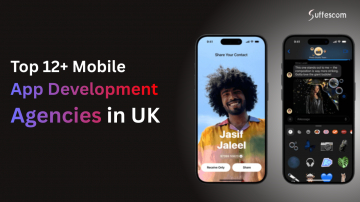Custom Healthcare Software Development in UAE | Saudi Arabia | Kuwait

The Future of Healthcare is Digital – Especially in the GCC
The healthcare market is shifting toward technology driven solutions at an accelerated pace. The UAE, Saudi Arabia, and Kuwait are setting the pace by introducing new digital health technologies. This revolution is about embracing new technology and about fulfilling increasing patient expectations. It has to do with operational efficiency and aligning with ambitious government-led projects such as Saudi Vision 2030 and UAE's Smart Health Strategy.
Healthcare organizations, private clinics, and healthtech startups are now in greater demand for custom healthcare software development. It typically struggles to meet regional regulatory standards, fall short on data protection requirements, and lacks patient interaction features. Many healthcare providers find it challenging to rely on them for day-to-day operations. Thus, businesses are constantly exploring custom-built applications. The solutions solve operational challenges and deliver meaningful value to both patients and medical staff.
Further, GCC governments are investing in smart healthcare infrastructure. It offers fiscal incentives that facilitate digital transformation in the public and private sectors. This forward-thinking approach offers substantial opportunities for healthcare organizations. It transforms their services and gains a competitive edge in a fast-digitizing market.
Why Custom Healthcare Software Is Booming in 2025
The demand for custom healthcare software development in UAE, Saudi Arabia, and Kuwait is expected to increase in 2025. Numerous factors are contributing to this rise, with one of the most impactful being the post-COVID healthcare digitization boom.
Post-COVID Digitization Surge
The pandemic changed how healthcare services are delivered. Many healthcare providers adopt digital platforms such as telehealth apps, remote patient monitoring, and virtual consultation systems because of rising patient volumes during lock down. These solutions were initially adopted so that their long-term benefits quickly became clear.
The demand for secure, systematic, and secure digital healthcare services remains high. Patients prefer convenient, on-demand care experiences. Healthcare providers aim to optimize operations that improve data management, and fulfill regulatory requirements.
The introduction of mandatory electronic health records is reshaping the world of healthcare. It includes information on how clinics and hospitals handle patient data. Healthcare organizations optimize customized systems that manage, store, and retrieve patient records. It helps to integrate with other digital tools like appointment scheduling, billing, and telemedicine services.
At the same time, growing private healthcare investments in the GCC are leading demand towards differentiated digital services. Private providers attract a wider patient base and improve profitability. By investing heavily in custom healthcare software, they get better patient engagement and operational efficiency.
UAE, Saudi & Kuwait – Regional Leaders in Healthtech
Each of these markets is setting new benchmarks in digital healthcare with strategies according to the national goals and patient needs.
UAE:
The UAE’s private healthcare sector is empowering digital platforms. From patient apps to remote consultations, healthcare providers are opting for custom solutions to stay ahead in the market.
As a growing hub for medical tourism focusing on smooth digital experiences is crucial. It makes appointment booking, virtual care, and health records accessible for both local and international patients.
Saudi Arabia:
According to IMARC Group’s market outlook, the Saudi digital health sector is projected to surge from USD 1.3 billion in 2024 to over USD 5 billion by 2033, fueled largely by AI adoption.
Saudi Arabia is leading a Vision 2030 healthcare overhaul to modernize its medical sector. The government is upgrading public sector medical institutions, Government-funded hospitals, and National healthcare centers that are implementing digital systems to boost care quality.
The main focus is on introducing electronic health records and upgrading hospitals with digital platforms. It helps in smoother operations, secure data handling, and better patient care.
Kuwait:
Kuwait is making steady progress through public-private healthcare partnerships. These are helping expand digital services in hospitals and clinics.
The country’s top priority is developing a centralized EHR system to improve patient data management. There’s a growing demand for custom healthcare platforms that seamlessly connect with national systems.
Regional Digital Health Landscape Overview
The healthcare technology landscape in the GCC is expanding rapidly. The UAE, Saudi Arabia, and Kuwait are taking distinct approaches to update their healthcare systems. Here are the points how these markets compare in terms of government initiatives, and regulatory frameworks.
Comparing Healthtech Readiness in UAE, Saudi, and Kuwait
Each country is moving at its own pace but shares one goal to improve care delivery through digital solutions. Their strategies reflect local needs, regulatory priorities, and healthcare infrastructure.
Government Healthcare Initiatives
UAE: The UAE has rolled out dedicated platforms such as Malaffi in Abu Dhabi and NABIDH in Dubai. These systems help in building unified patient records for smooth data sharing across healthcare facilities.
Saudi Arabia: The country introduced the Seha Virtual Hospital, one of the largest remote care networks globally. It also runs the NPHIES platform, which standardized patient data exchange between public and private providers.
Kuwait: The Ministry of Health is building a centralized patient data program. This initiative is giving emphasis on linking public hospitals and clinics to improve care coordination and patient record management.
Regulatory Environment
Across the GCC, compliance with national health data privacy laws is mandatory. Every healthcare software platform must align with these rules and regulations.
Additionally, both UAE and Saudi Arabia implement GDPR and HIPAA-level security standards for private healthcare providers. It ensures patient data protection and safe digital transactions across hospitals, clinics, and virtual health services.
Market Maturity
Each market offers different opportunities based on healthcare infrastructure and digital adoption.
UAE: Best suited for private hospital groups and specialty care centers. Strong digital infrastructure and high patient demand drive growth in this segment.
Saudi Arabia: Ideal for public sector healthcare tech vendors. The government's digital health programs and hospital network upgrades create steady demand for large-scale solutions.
Kuwait: It is well-reputed for SME clinics, hybrid care models, and telemedicine platforms. The growing focus on public-private partnerships that support innovation in outpatient and wellness services.
What Is Custom Healthcare Software?
Custom healthcare software refers to tailor-made digital solutions that are designed to fulfill the operational and patient management needs of healthcare providers. These solutions are built around the specific workflows, and service models of a healthcare business.
Understanding the Scope of Healthcare Solutions
Today’s healthcare organizations manage patient records and billing. From virtual consultations to chronic disease management, the need for versatile and integrated digital tools has never been higher. Custom healthcare software bridges these gaps by offering solutions built to match real operational requirements.
Types of Custom Health Software

Let’s explore the most in-demand healthcare software solutions and how they help healthcare businesses run better.
Clinic Management Systems
These systems help to manage appointments and automate various administrative tasks. From managing patient records, tracking inventory, and processing billing. Clinics can streamline their operations, avoid administrative errors, and improve patient service without overcomplicating workflows.
Electronic Medical/Health Records (EMR/EHR)
Patient data management is now more than simply filing reports. In an environment of rigid privacy legislation and increasing patient expectations, having a secure, accessible system in place is critical. EMR and EHR systems include patient histories, laboratory results, prescriptions, and treatment plans in a safe location. With increasingly stringent healthcare regulations, solid electronic records are a necessity.
Hospital Information Systems (HIS):
Larger hospitals need systems to manage multiple departments. From admissions through discharge and everything in between, it needs a system that keeps it all linked. It automates administrative functions, eliminates paper delay, and enhances interdepartmental coordination. Helps in streamlining operations and enhancing patient care.
Telemedicine Platforms:
Virtual medicine is now an everyday option, particularly after the pandemic. Telemedicine software allows physicians to consult with patients via video calls, online messaging, and remote follow-ups. It reduces waiting time, enhances patient access, and facilitates home-based chronic care management.
Patient Portals:
Today’s patients want quick access to their health information. Patient portals provide just secure access to health records, prescriptions, appointment details, and test results. These platforms reduce front desk workloads and, at the same time, give patients more control over their care.
AI-Based Symptom Checkers
Not every patient issue needs an immediate appointment. Symptom checkers help patients to concern their basic health issues without going to the clinic. It also helps providers to manage appointment priorities, limit unnecessary visits, and offer peace of mind by using home self-assessments.
Insurance claim processors:
Managing insurance claims manually slows down the operations. Thus, opting the custom claim processing systems automates the submission, approval, and reimbursement process. This speeds up the payment processing, report generation, and reduces administrative burden. It improves coordination between hospitals, clinics, and insurance companies by maintaining all claim-related data in an accessible platform.
Key Benefits of Going For Custom Healthcare Software
Custom healthcare solutions help providers meet strict data laws, improve workflows, and build stronger patient connections:
Greater Control Over Data Security
Handling sensitive patient data is a big responsibility. With custom-built software, get control of how patient records are manages, stored and accessed. It is easier to align systems with local regulations such as NABIDH or Seha while meeting international standards, including HIPAA and GDPR. It reduces the risk of breaches and reassures patients that their information is in safe hands.
Smooth Integration into Current Systems
Another key benefit is how seamlessly custom applications integrate into your existing workflow. In contrast to plug-and-play solutions, these platforms can be developed to integrate harmoniously with your hospital machinery, admin processes, and compliance audits. This means you minimize workflow interruptions and your staff can transition without requiring weeks of additional training. Essentially, business remains efficient, and your teams remain agile.
Stronger Brand Differentiation
Custom solutions allow the flexibility to design every aspect. Whether it is related to aesthetics of patient portal or the functionality in your wellness app. It offers experiences that align with your care philosophy and differentiates the app in a competitive healthcare market.
Better Operational Efficiency
Custom software simplifies admin-heavy processes like appointment scheduling, claim processing, and patient reporting. Instead, it needs more time to focus on actual patient care, while managers get instant access to useful performance insights. It’s a win-win for both efficiency and service quality.
Healthcare Software Use Cases by Country
Popular Healthcare Software Use Cases in UAE, Saudi Arabia, and Kuwait
These regional use cases reflect how healthcare providers are actively transforming operations to meet growing patient demands. It includes different countries' use cases such as:
UAE:
The UAE is at the forefront of the region in medical tourism and private healthcare innovation. Top use cases are:
- Digital processing of insurance claims and integration with NABIDH, supporting smooth insurance approvals and improved reimbursements.
- Patient tracking systems for medical tourism patients allow hospitals to handle overseas patient care, schedule travel, and provide post-treatment follow-ups.
- Wellness and lifestyle management apps customized for private hospitals and specialty care providers providing preventive care services and patient engagement.
Saudi Arabia
With its Vision 2030 overhaul of healthcare, Saudi Arabia is sharply concentrated on public health tech transformation. Some important use cases here are:
- Triaging systems powered by artificial intelligence aid the Seha Virtual Hospital, assisting in prioritizing critical cases and directing patients to appropriate specialists.
- Appointment scheduling and queue management software for government hospitals, decreasing waiting times and enhancing patient flow.
- Integrated electronic medical record (EMR) solutions for clinics on the NPHIES platform, consolidating patient health information across numerous providers.
Kuwait
The healthcare market in Kuwait is inclined towards functional, business-oriented solutions for private clinics and public-private partnerships. Typical applications include:
- Pharmacy stock management and prescription tracking systems to enhance drug visibility and prevent medicine shortages.
- Clinic software with bilingual patient apps, supporting both Arabic and English-speaking patients, to enhance appointment scheduling.
- Cloud-based physician dashboards allow healthcare professionals to securely view patient records, laboratory test results, and schedules of appointments remotely.
Essential Features in GCC-Focused Healthcare Software

Must-Have Modules for 2025
As healthcare providers across the UAE, Saudi Arabia, and Kuwait continue enclosing digital transformation. For 2025, any reliable custom healthcare solution should be equipped with modules that offers clinical care, admin operations, and patient engagement.
Clinical Features
At the heart of any healthcare platform lies its clinical functionality. These modules directly impact patient outcomes and care efficiency.
ePrescriptions: Extinguish paper-based prescriptions by integrating secure electronic prescription tools that connect with local pharmacies and regulatory systems.
ICD-10 Medical Coding: Ensure accurate, standardized disease classification using ICD-10 coding for insurance claims, reporting, and medical record management.
Patient History and Allergy Tracking: Maintaining comprehensive patient records, such as medical history, allergy alerts, and chronic conditions, helps to track personalized care.
Administrative & Financial Features
Operational efficiency isn’t optional in the GCC’s fast-evolving healthcare environment. Custom software should simplify financial management and resource coordination.
Insurance Claim Automation: Accelerate revenue cycles with electronic payments claim processing systems, interfaced with systems like NABIDH and NPHIES as and when required.
VAT-Compliant Billing and Co-Pay Handling: Streamline patient billing for co-payments, deductible calculations, and VAT adjustments according to GCC tax laws.
Doctor Availability Scheduling: Automate physician schedules, appointment reservations that helps to minimize administrative lag and boost patient access.
Advanced Patient-Centric Features
Apart from clinical and admin fundamentals, healthcare platforms in 2025 require innovative tools to boost patient experience and remote care functionality.
Symptom Analysis with AI: Incorporate AI-based modules for symptom checkers and triage software that direct patients to the right services or highlight critical cases. For instance, in 2025, Saudi Arabia launched ‘Dr. Hua,’ the first globally certified AI-driven clinic for diagnosing and prescribing common conditions.
Teleconsultation Video Module: Provide secure, high-definition teleconsultation services that facilitate video calls, digital prescriptions, and remote follow-ups of patients.
Multi-Lingual Patient Support: Develop platforms with multi-language support, incorporating Arabic, English, Urdu, and other most spoken regional languages. It increases access and inclusivity in patient care.
Cost of Custom Healthcare Software in UAE, Saudi Arabia, Kuwait
The right investment in custom software balances cost with long-term operational value, future scalability, and regulatory peace of mind.
Country-Wise Healthcare Software Cost Table (USD + Local Currencies)
Mobile App vs Web Portal for Patients & Doctors

The most innovative providers in the UAE, Saudi Arabia, and Kuwait are combining platforms to offer secure, patient-friendly care experiences.
Mobile App Benefits
Mobile apps are gaining constant popularity in the GCC’s healthcare sector. It is particularly among private clinics, telehealth platforms, and wellness service providers. Here are the points:
Easy Patient Access: Patients can book appointments, schedule patient visits, request medical consultations, reserve healthcare services to consult with doctors anytime, anywhere by using their smartphones. It improves convenience and patient engagement, specifically in urban centers like Dubai and Riyadh.
Push Notifications: Send reminders using mobile apps to minimize no-shows and improve appointment management. Besides that, clinics send prescription alerts, lab report updates directly to patient devices.
Video Consultations: Integrated teleconsultation modules make it simple for doctors to conduct video appointments, manage follow-ups, and share digital prescriptions. It is a growing need in both post-COVID care and chronic disease management sectors.
Web Portal Benefits
Whereas mobile apps are necessary for on-the-beach patient-facing services, web portals are still vital for hospital administrators, clinic managers, and medical staff. Here's why they are important:
Richer Analytics Dashboards: Specific web portals can incorporate richer data analytics, revenue reports, and operational KPIs geared towards hospital management teams. This enables decision-makers to monitor performance and spot areas for operational optimization.
Staff/Admin Utilization: Functions such as appointment scheduling, insurance claims management, and billing reconciliation are usually more manageable through web portals, especially in bigger hospital environments.
Desktop-Dominant Clinics: For multi-specialty hospitals and government clinics, where desktops continue to be the operational core, web portals fit well into current HIS (Hospital Information Systems) and EMR environments, providing a more viable and scalable solution.
Tech Stack for Scalable GCC Health Apps
A carefully selected tech stack ensures operational efficiency, data security, and smooth integration with national health systems in the GCC.
Frontend Technologies
ReactJS (for admin dashboards): Works great for hospital management panels. It’s fast, flexible, and easy to customize as your operations grow.
Flutter (for cross-platform mobile apps): Saves time by letting you build one app for both Android and iOS. Ideal for patient and doctor apps.
Swift & Kotlin (for native apps): Best choice when you need high performance, especially for apps with video calls or complex device integrations.
Backend Technologies
Node.js: Handles real-time activities smoothly. Perfect for apps with live appointment updates or teleconsultations.
Django: Comes with built-in security features and admin tools. Suitable for managing large, sensitive patient databases.
.NET: A reliable enterprise option, especially for hospitals already using Microsoft infrastructure.
PostgreSQL: Great for handling structured healthcare records like EMRs, prescriptions, and invoices.
MongoDB: Better for unstructured data like radiology files or scanned reports. Works well alongside PostgreSQL.
HIPAA & FHIR-compliant architecture: Ensures your app follows international healthcare data safety standards — essential for GCC hospitals handling expat or global patients.
Security & Hosting
256-bit encryption: Keeps sensitive patient data secure while stored and in transit.
Role-based access control: Limits who can view and edit critical patient information. Helps avoid data breaches internally.
Local hosting providers: Required for most GCC countries. Go with:
- G42 Cloud in the UAE
- STC Cloud in Saudi Arabia
- Zajil Telecom in Kuwait
API & Integration Tools
GraphQL: Useful for querying large EMR systems or insurance databases efficiently.
REST APIs: Standard choice for integrating with regional platforms like NABIDH, Malaffi, and NPHIES.
WebRTC / Twilio / Agora: Reliable for encrypted video calling and telemedicine consultations.
Database & Storage
PostgreSQL: Handles structured data like patient profiles, appointments, and billing records.
MongoDB: Manages unstructured content such as scanned documents and diagnostic images.
Elasticsearch: Speeds up search within large, multilingual patient databases.
Healthcare Software Launch & Compliance Checklist
Before rolling out any healthcare software in the UAE, Saudi Arabia, or Kuwait, it’s crucial to cover your legal and compliance bases. And let’s be honest about the GCC’s tightly regulated health sector, skipping even a small requirement causes operational delays or licensing issues. Here is a simple checklist to consider before your platform goes live.
Legal Registration & Hosting
Every country has its own digital health rules, and following them is crucial. Let’s have a look what you need to consider:
UAE: If you’re launching in Abu Dhabi, you’ll need to connect your app to Malaffi. For Dubai-based hospitals and clinics, integration with NABIDH is mandatory. These systems help create unified patient records, and no integration means no operational approval.
Saudi Arabia: Here, you must register on the platform under the National Health Information Center (NHIC). Also, make sure your hosting is handled within KSA-based data centers. This isn’t just a good-to-have; it’s a hard requirement under Saudi personal data laws.
Kuwait: The Ministry of Health has its own security protocols you’ll need to follow. It includes patient data locally and ensures all hosting meets their privacy and security guidelines. It might feel a little old-school, but it is crucial to follow it as it's the law.
Certifications
Once your hosting and registrations are sorted, don’t forget about your international compliance. While the GCC has its own privacy laws, meeting global benchmarks adds trust and makes partnerships smoother.
ISO 27001: This one’s about protecting patient and business data. It is an internationally recognized security certification and a must-have if you want hospitals and insurers to take your platform seriously.
GDPR & HIPAA Alignment: Even though not legally required in all GCC countries, aligning with GDPR for EU-based patients and HIPAA for U.S. patients or medical tourists helps avoid problems. It shows seriousness about patient privacy, which is always a plus point.
HL7 & FHIR Standards: If your software needs to exchange data with hospital EMR or insurance systems. HL7 and FHIR standards make those integrations much easier. It saves you from costly custom interfaces later.
Marketing Your Healthcare App
GCC-Specific Healthcare Marketing Tips
Building a great healthcare app is one thing, but getting it in front of the right audience takes a different kind of strategy. In the UAE, Saudi Arabia, and Kuwait, healthcare marketing works a little differently. It includes dealing with patients, but also insurers, hospital administrators, and regulatory agencies. Here’s how to approach it the right way.
Marketing healthcare apps in the GCC requires more than generic online adverts. For private clinics, hospitals, and healthtech companies as B2B players, LinkedIn and Google Ads provide direct access to decision-making teams and procurement teams. In contrast, patient interaction and appointment reminders need nothing more than WhatsApp and SMS campaigns; they are trusted, intimate, and fast to convert. Facebook and Instagram continue to be invaluable to pharmacy apps and health platforms. It provides a localized audience targeting and bilingual content options that align with the region's online behavior.
Arabic and English video explainers for your app's features, health packages, or claim processes establish trust more quickly than text-based promotions. Ramadan and National Day seasonals also provide high-value opportunities to market teleconsultations, health check-ups, and wellness promotions. Partnering with local medical influencers lends credibility, enabling healthcare brands to win patient trust and drive visibility in an otherwise competitive, regulation-focused market.
When & Where to Start
UAE
If you're eyeing the GCC market, the UAE is often where most businesses prefer to start. Why? Because it’s a hotspot for private hospitals, wellness clinics, and medical tourism. Most healthcare providers here look for systems that aren’t just secure but also polished and multilingual. Beyond that, local regulations demand tight data control, which makes custom healthcare software a natural choice. It’s not just about technology; either the UAE healthcare scene values branding and patient experience, so apps that offer appointment booking, insurance claim management, and remote monitoring tend to do well.
Saudi Arabia
Now, if your priority is market size, Saudi Arabia’s the one to watch. Thanks to its Vision 2030 healthcare overhaul, the country’s been investing heavily in digital systems for both public and private care. What makes it interesting is how government-backed projects like NPHIES and Seha Virtual Hospital create steady demand for everything from EMR/EHR software to AI-powered patient triage tools. Plus, hospitals across the country are modernizing fast, and many still need tailored tech to handle appointments, records, and teleconsultations. In other words, there’s space for vendors with scalable, reliable, and localized solutions.
Kuwait
For those wanting to test products without diving straight into massive investments, Kuwait offers a sensible starting point. The healthcare market is smaller, but what makes it attractive is the lower cost of entry and a growing appetite for clinic management software, bilingual patient apps, and cloud-based systems. Many SME clinics are actively looking to automate processes such as scheduling, pharmacy management, telemedicine and more. So, if you need a lean, manageable market to navigate your healthcare app before expanding into Saudi or the UAE, Kuwait is a strategic option.
Get Your Idea Convert in a Software!
Get a healthcare software developed from our expert healthcare software developers having experience in healthcare industry.
FAQs
1. How much does healthcare software cost in UAE?
The cost of UAE healthcare software generally spans between $12,000 and $80,000, based on the functionality, integrations, and type of platform. The costs are higher here due to stringent rules of compliance and high-end design requirements from private healthcare organizations.
2. What is the cost of developing a telemedicine app in Saudi Arabia?
A standard telemedicine app in Saudi Arabia generally begins at $35,000 and reaches up to $70,000. The actual cost is depends on video quality, integration of NPHIES platform , and the inclusion of AI-based triage features.
3. What software do hospitals in Kuwait use?
Most clinics and hospitals in Kuwait use either custom EMR systems or simple clinic management software. These mostly support appointment scheduling, pharmacy management, bilingual patient records, and insurance claims processing.
4. Is healthcare software development different for UAE and Saudi?
Yes, priorities are very different. In the UAE, healthcare software tends to be centred on private insurance integrations, patient experience, and branded digital services. Saudi Arabia, by contrast, is centred on integration with national platforms such as NPHIES and big-scale, public-sector hospital networks.
5. What languages should be supported in GCC health apps?
At a minimum, your app should support Arabic and English. In regions with large expat communities like the UAE and Kuwait, adding Urdu, Hindi, or Tagalog can improve patient adoption and accessibility.
6. Is HIPAA required in GCC?
It's not mandatory from a legal perspective in most countries of the GCC. But HIPAA compliance is usually anticipated particularly by UAE hospitals, telemedicine providers, and any app catering to international patients. It establishes credibility and makes insurance collaborations easier as well.
7. Can I integrate video calling in a medical app?
Definitely. You can include video consultations through platforms such as Twilio, Agora, or WebRTC. Just ensure that you are implementing end-to-end encryption and patient consent for each remote medical consultation.
8. What are key features of EMR software?
The major modules in a good EMR system are ePrescriptions, lab integrations, patient records, ICD-10 coding, appointment scheduling, and billing management. Some platforms include insurance claim handling and reporting dashboards.
9. Can AI be used in health software for diagnosis?
Yes, but with certain conditions. Symptom checkers and AI-assisted triage tools are very common in KSA and UAE. But they're generally only used for initial guidance and must prominently show disclaimers indicating they don't take the place of a doctor's recommendation.
10. Is cloud hosting allowed for healthcare apps in Saudi Arabia?
Yes, but with limitations. Cloud hosting is allowed as long as it's local server-based. Typical options are STC Cloud or Saudi-hosted solutions on AWS and Azure that are compliant with healthcare data privacy laws.
11. What tech stack is used in GCC health apps?
Most GCC region health platforms utilize ReactJS or Flutter for the frontend and Node.js or .NET for the backend. PostgreSQL and MongoDB, being HIPAA-compliant databases, are used in particular for the management of sensitive patient data.
12. How long does it take to build health software in the GCC?
On average, it takes a healthcare platform around 3 to 6 months to create. The timeframe relies on the number of modules you require, third-party integration such as NPHIES or NABIDH, and the speed at which regulatory clearances are received.







